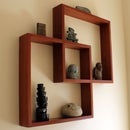Introduction: Space Invaders Bar
A couple of years ago my brother bought a beautiful slab of jarrah from a local wood mill. Jarrah is a native timber to Western Australia, is very hard and has a deep red colour. He asked for my help in constructing a bar for his entertainment room to complement his jarrah pool-table. We decided to keep the bar fairly simple in its construction but with the added effect of plasma cut mild steel panels.
Step 1: Creating the Bar Frame
We used a combination of simple jointing techniques, such as Mortise and Tenon and Housing joints. These were cut with a table saw, although you could achieve the same thing with a router. The space where the bar was to go was fairly tight so we kept the width of the frame to a minimum. Much of the wood we used was salvaged so our design was limited to the sizes we had available.
Step 2: Gluing and Finishing the Frame
We filled in any imperfections in the wood with a 2-part epoxy resin and sanded with a range of sandpaper grits until perfectly smooth. The joints were glued with the same resin and clamped together with large sash clamps making sure all corners where square. We then used a floor varnish to finish the bar, one reason being its lower price for a larger volume and secondly due to its hard wearing properties.
Step 3: Fixing Bar Into Position
Due to the narrowness of the bar and the fact that we did not want it to move, we decided to dyna-bolt it into the floor for maximum strength. The brackets used to bolt the bar to the floor are sections of angle-iron cut and pre-drilled to size.
Step 4: Designing the Steel Panels
The design for the steel panels required some careful thinking and decision making. It had to be something reasonably recognisable but not over the top. My brother got the idea of a space invaders theme from a card he received for his birthday. Once we knew what we were after we started to draw on CAD in readiness for a CNC plasma machine. We mixed and matched some of the alien types for each panel.
Step 5: Cutting the Steel Panels
The panels were cut from 1.6mm mild steel sheets using a PlasmaCAM machine. The CAD file had to be imported into the PlasmaCAM program and a cut-path programmed to control the machine operation.
Step 6: Finishing the Bar
The panels were polished with a car body cleaner/wax. We considered varnishing or painting the panels for added protection, but liked the industrial look of raw steel. My brother wanted the panels to be flush with the edges of the frame and removable, so we decided to attach them to the bar using rare-earth magnets. This also removed the need for screws or bolts, giving a cleaner aesthetic to the design. The magnets were inset into the shelf structure behind the panels. The last effect was the installation of adhesive-backed remote-controlled LED strip lights behind the panels to shine various colours of light through.



